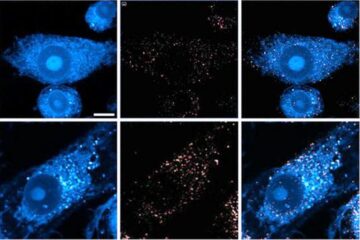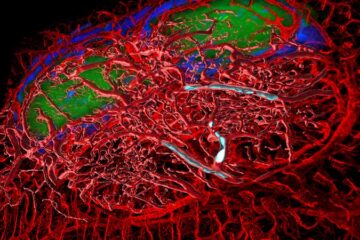Common bacteria pirate natural mechanism to get inside cells

Bacteria and viruses utilize a natural mechanism to get inside cells and grow, researchers say.
These pathogens gain entry the same way millions of receptors on the cell’s surface routinely do after they get activated, says Dr. Yehia Daaka, professor and Distinguished Chair in Oncologic Pathology at the Medical College of Georgia. Dr. Daaka is corresponding author on an article published Jan. 23 by Proceedings of the National Academy of Sciences.
By moving off the cell surface, receptors gain some respite from their activating signals, Dr. Daaka says. Receptors can either stay inside the newly created vesicle and be degraded or resurface to be activated once again.
Bacteria and viruses also want inside cells and out of the direct line of fire of the immune system or treatments such as antibiotics for bacterial infections, Dr. Daaka says. “Some bacteria and viruses bind to receptors on the plasma membrane and use them to go inside, and that is how they start replicating inside the cell,” he says.
He and colleagues at Howard Hughes Medical Institute and Duke University Medical Center also have found that the short-lived, ubiquitous gas, nitric oxide, is a primary enabler for receptors and pathogens to make this move.
“When there is a signal, the plasma membrane on the cell surface invaginates – think of a plasma membrane as a balloon and you poke your finger in it,” he says. “The protein, dynamin, comes along and forms a necklace around the neck of that balloon, then chops it off,” he says of the process that is ongoing with millions of receptors on the cell surface. “Adding nitric oxide to dynamin changes it from an inactive protein inside the cell to the active protein that mediates the fission of the vesicle inside the cell.”
Apparently, bacteria and viruses can increase nitric oxide levels to make this normally protective system work for them as well.
Identifying this role of nitric oxide provides a new target for finding better methods to prevent infections, Dr. Daaka says. “In the case of bacteria, hiding inside the cells is dependent on dynamin. What we could do is limit internalization and ensuing infection by controlling dynamin activity through the inhibition of nitric oxide synthases, enzymes that produce nitric oxide.”
The new research uses the common bladder infection-producing uropathogenic E. coli as a model to show how nitric oxide unwittingly assists bacterial uptake and survival.
“In bladder cells, E. coli uses this mechanism to get inside the cells and hide from the antibiotic effect and the immune system,” says Dr. Daaka. “We think their hiding is mediated through dynamin. This is not only applicable to this particular pathogen but for many more.”
Dr. Daaka, who studies receptor signaling, likens receptors to television antennae that control relay of signals from outside the cell to inside by turning on or off. Although there are no known receptors that have the job of triggering a bad result in the body, receptors that are ‘on’ too much may end up instructing the cell to do bad things, he says. “The hypothesis is that in cancer, for example, the receptors get stuck on ‘on’.”
Receptor over-stimulation also helps explain why some drugs stop being effective over time. “What that means is there are no more receptors outside the cells to be affected by the drugs,” Dr. Daaka says. “This is a self-regulatory mechanism for cells. You don’t want your receptors to always be on.”
Interestingly, this self-regulatory mechanism seems to work best when a receptor, not a bacteria, is the instigator. Unlike receptors, bacteria and viruses don’t degrade if they stay inside the vesicles because fusion with a second vesicle that enables the degredation doesn’t happen, says Dr. Daaka, a Georgia Cancer Coalition Distinguished Cancer Scholar.
The research was funded by the National Institutes of Health.
Media Contact
More Information:
http://www.mcg.eduAll latest news from the category: Life Sciences and Chemistry
Articles and reports from the Life Sciences and chemistry area deal with applied and basic research into modern biology, chemistry and human medicine.
Valuable information can be found on a range of life sciences fields including bacteriology, biochemistry, bionics, bioinformatics, biophysics, biotechnology, genetics, geobotany, human biology, marine biology, microbiology, molecular biology, cellular biology, zoology, bioinorganic chemistry, microchemistry and environmental chemistry.
Newest articles

Zap Energy achieves 37-million-degree temperatures in a compact device
New publication reports record electron temperatures for a small-scale, sheared-flow-stabilized Z-pinch fusion device. In the nine decades since humans first produced fusion reactions, only a few fusion technologies have demonstrated…

Innovative microscopy demystifies metabolism of Alzheimer’s
Researchers at UC San Diego have deployed state-of-the art imaging techniques to discover the metabolism driving Alzheimer’s disease; results suggest new treatment strategies. Alzheimer’s disease causes significant problems with memory,…

A cause of immunodeficiency identified
After stroke and heart attack: Every year, between 250,000 and 300,000 people in Germany suffer from a stroke or heart attack. These patients suffer immune disturbances and are very frequently…





















